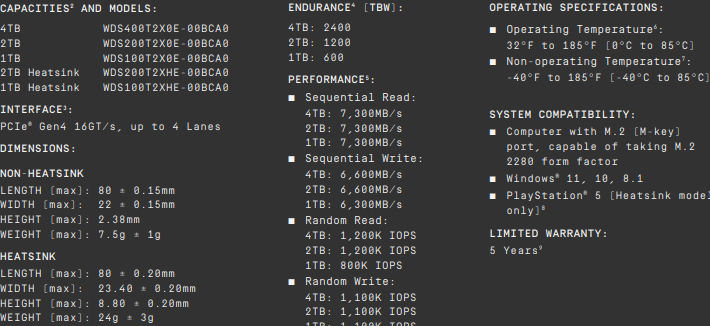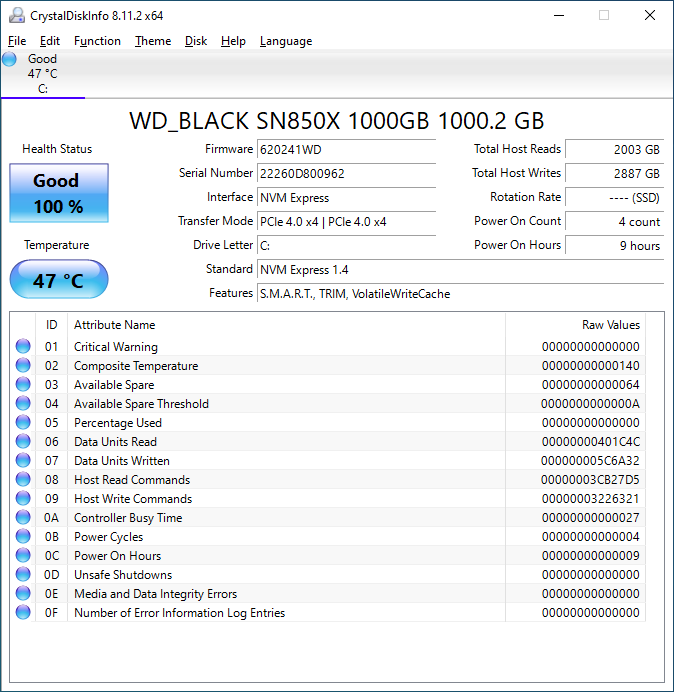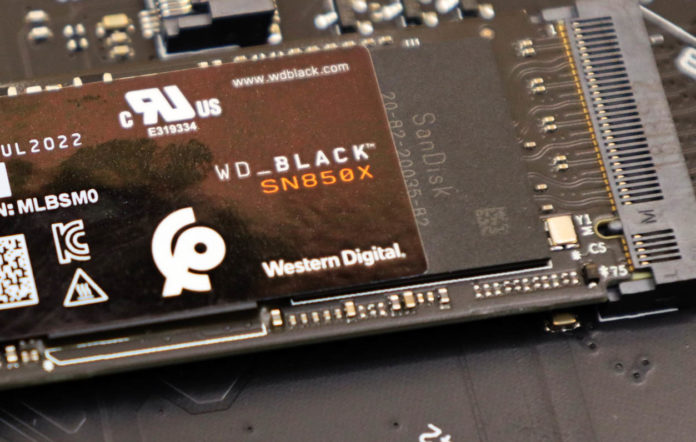Today we are looking at WD’s relatively new SN850X. This Black-line drive is the successor to WD’s Black SN850 which we have previously covered. The original WD Black SN850 was part of the second wave of PCIe Gen 4 drives, and as such was one of the first drives to really push the limits of what a PCIe 4.0 x4 interface can handle. The SN850X is here to follow up, offering relatively similar specs but with an updated set of internal components. Also, for brevity, I will be referring to this drive as simply the SN850X rather than the WD Black SN850X for most of this review, just because that is a bit long-winded.
WD Black SN850X 1TB NVMe SSD
The WD SN850X 1TB comes in a single-sided M.2 2280 (80mm) form factor and is available both with and without a heatsink. My review model is the bare drive.

Similar to the original SN850, the new X model is fairly vertically integrated. By that, I mean that the controller is a custom SanDisk design, SanDisk being wholly owned by WD. In addition, the NAND on the SN850X is BiCS5 112-layer TLC, and BiCS5 was co-developed by WD and Kioxia. The controller used on the SN850X would appear to be an updated version of the one used on the SN850, with the SN850X model marked as B2 and the original SN850 marked as A1. 112-layer TLC is also an upgrade, as the original SN850 used 96-layer NAND. Rounding out the drive components is a DDR4 DRAM cache.
As mentioned, my review model of the SN850X does not include a heatsink but the design of the heatsink model seems nearly identical to the original SN850, and I believe my criticisms of that heatsink will be applicable here. To reiterate from my original review, potential buyers need to be aware this heatsink is not intended to be removable. Removing the heatsink will damage either the heatsink, the SSD, or both. When I removed the original SN850 from its heatsink, the heatsink could never be used again because the metal clips were permanently bent. The inability to remove the heatsink might affect some users with motherboards that have built-in M.2 heatsinks, and if that is the case, then buyers need to take care to acquire the SN850X that comes without the heatsink. Once again, I hope that in the future, WD can settle on a heatsink design that is removable in a non-destructive manner similar to the recently reviewed Lexar NM800 Pro.

WD SN850X 1TB BackThe back of the SSD is essentially blank.
WD SN850X SSD Specs
The SN850X line of SSDs is available in sizes between 1 TB and 4 TB.

This is the first time that reviewing a 1TB model drive means I am looking at the baby of the SKU list. In the future, STH will be standardizing on 2TB SSDs; that move will come with the new PCIe Gen5 compatible test platform. Stay tuned for news on that in the future!
For now, looking at the 1TB model drive we have rated sequential read speed of 7300 MB/s and sequential write of 6300 MB/s. Both of these represent moderate improvements over the original SN850 1TB model, which was rated for 7000 MB/s and 5300 MB/s, respectively.
The endurance and warranty, on the other hand, have stayed consistent with the first gen SN850 drive. 600 TBW is exactly the amount I consider acceptable for a premium drive, though many high-quality drives now exceed that amount. A 5-year warranty is also the industry standard for drives of this caliber, so it is good to see that here.

CrystalDiskInfo can give us some basic information about the SSD and confirms we are operating at PCIe 4.0 x4 speeds using NVMe 1.4.
Test System Configuration
We are using the following configuration for this test:
- Motherboard: ASUS PRIME X570-P
- CPU: AMD Ryzen 9 5900X (12C/24T)
- RAM: 2x 16GB DDR4-3200 UDIMMs
Our testing uses the WD SN850X 1TB as the boot drive for the system, installed in the M.2_1 slot on the motherboard. The drive is filled to 85% capacity with data and then some is deleted, leaving around 60% used space on the volume.
Next, we are going to get into our performance testing.





The factor two difference in sustained write between this and SSDs with otherwise similar performance makes me think more attention should be given to this metric.
Compared to cache sizes that have been tuned to popular benchmarking tools, sustained write performance might be a more meaningful number, especially if one is rebuilding a ZFS storage pool, mirror RAID or even BTRFS.
With heatsinks less expensive then without… Feels like being scammed….
I bought one of these, and I find that simply does not work under linux (at least on my X570 motherboard with Ryzen 5950X) due to power/sleep state issues. I’ve replaced it with a Rocket 4 Plus, and I’m still hoping to repurpose the SN850X elsewhere…
One nice thing about this series of drives is unlike the Samsung 9×0 Plain/Evo/Pro consumer line of SSDs the WD Black line can be reformatted with 4K LBA instead of 512. In certain applications this has dramatic benefits. I note that neither latency nor CPU usage appears in the review, and those are two things you would expect to improve with a larger logical block.
For example, my WD vs. Samsung SSD in the same system, QD=1 single-threaded random reads, I get 89% more IOPS on the WD, with one third the latency (11µs vs. 30µs at the median) with only 31% more CPU used (that is, 24% *less* CPU per IO).
On the other hand the WD runs out of gas earlier. The Samsung with more internal parallelism can hit 800k IOPS with 8 threads and QD=8, while the WD runs out of juice at 450k IOPS at 8 threads regardless of queue depth. So there are tradeoffs in both these controller architectures.
The SN850X saved 1 degree and lost 25% of the sustained performance compared to the older SN850. It makes no difference for daily usage, but when cloning drives frequently, wasting 25% more time is out of the question.
Thank you Will for including all the latest 1TB drives in your review. I had to check older reviews to see the temperature of the rest of the drives. Hope you’ll include all of them in future reviews.
What is the advantage of leaving the back side of the PCB blank? Is it just for cost savings (not having to use 2 extra flash chips) or is there another reason?